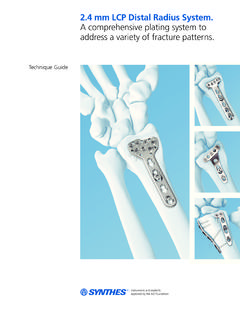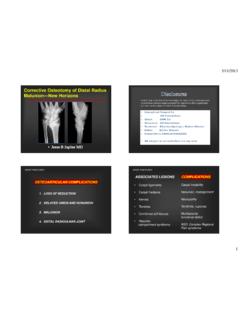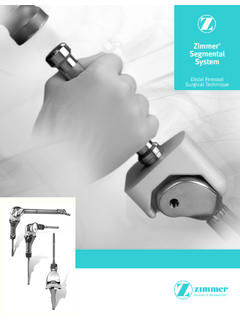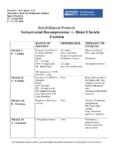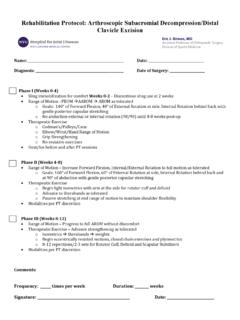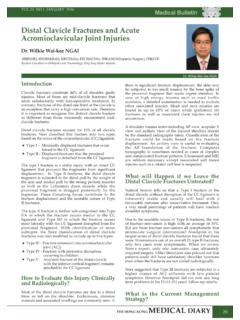Transcription of Predicting the Outcome of Distal Radius Fractures
1 Hand Clin 21 (2005) 289 294. Predicting the Outcome of Distal Radius Fractures David J. Slutsky, MD, FRCS(C). Private Practice, 3475 Torrance Blvd., Suite F, Torrance, CA 90503, USA. The anatomic results of fracture treatment fracture collapse [8]. Several studies have deter- have no meaning unless they are considered in mined that the severity of the initial radial light of the functional Outcome [1]. There are shortening alone seems to be a reliable indicator myriad factors a ecting the clinical result follow- of instability [9 11]. ing a Distal Radius fracture . It is useful to identify In patients older than 60 years of age, Leone those factors that have some predictive value with et al found that the degree of radial shortening and regard to fracture instability, patient satisfaction, volar tilt and the amount of dorsal comminution and hand function. These variables are discussed were predictive of early or late failure.
2 An un- in light of the speci c Outcome of interest. expected nding was that in patients older than 65. years of age, one third of the initially undisplaced Fractures subsequently collapsed [12]. Nesbitt et al Predictors of fracture instability determined that age was the only statistically A fracture of the Distal Radius is considered to signi cant predictor of secondary displacement. be unstable if it is unable to resist displacement After obtaining an acceptable initial closed re- once it has been reduced anatomically. There are duction, those patients who were more than 60. di culties in Predicting fracture instability re- years of age had four times the risk for failure liably based on the radiographs alone. MacKen- within the initial 4 weeks as compared with ney and Adolphson et al [2] have devised scoring younger patients. The risk for displacement in- systems to calculate the probability of fracture creased with each subsequent decade [13].
3 Instability on the basis of the initial presentation It is apparent that late fracture displacement is and the injury lms. In a prospective study of 80 common in elderly patients, which may be related patients, both scoring systems were found to to their lower bone density. Thought should be underestimate the degree of fracture instability given to adjuvant percutaneous or external xation and to have a poor correlation with the predicted in the healthy, active elderly patient if there is a loss and the actual instability [3]. of fracture position in the rst month. Greater The standard radiographic parameters of the force is necessary to fracture the Radius in younger Distal Radius include a radial inclination of 23 patients because of their higher bone density, (range, 13 30 ), a radial length of 12 mm (range, which can result in more comminution and a higher 8 18 mm), and an average volar tilt of 12 (range, risk for subsequent fracture collapse [14].)
4 Supple- 1 21 ) [4 7]. Lafontaine et al identi ed several mental internal or external xation is indicated in risk factors associated with secondary fracture younger patients for Fractures with O2 mm of displacement despite a satisfactory initial reduc- radial shortening and O15 of dorsal tilt following tion. These included the presence of dorsal tilt a closed reduction, especially if there is comminu- O20 , comminution, intra-articular involvement, tion of two or more cortices [15,16]. an associated fracture of the ulna, and age greater than 60 years. If three or more of these factors Predictors of osteoarthritis were present there was a high likelihood of Knirk and Jupiter retrospectively reviewed 43. intra-articular Fractures in 40 young adults (mean E-mail address: age, years) with a mean follow-up of 0749-0712/05/$ - see front matter 2005 Elsevier Inc. All rights reserved. 290 SLUTSKY. years. Thirty-eight Fractures were treated with cast 5 mm [23].
5 This nding does not seem to change or pins and plaster. Accurate reduction of the over time. Eighty- ve patients with displaced articular surface was the most critical factor in Colles Fractures were reviewed 10 years after the achieving a successful result. Radiographic evi- injury. Initial and 10-year radial shortening and dence of arthritis developed in 100% of the early nger sti ness signi cantly correlated with Fractures whose articular incongruity was 2 mm nal Outcome . Dorsal angulation in uenced early or more, in contrast to only 11% of the Fractures but not 10-year function [24]. that healed with a congruous joint [17]. Altissimi Combined deformities are also of signi cance. et al analyzed the outcomes of 59 patients with Fractures healing with more than 2 mm of axial comminuted intra-articular Fractures of the Distal compression and O15 of dorsal angulation have Radius who had received conservative treatment, compromised outcomes [25,26].
6 At an average follow-up of years. Thirty-one percent of the patients with greater than 2 mm of Intracarpal lesions residual articular malalignment were noted to Arthroscopic evaluation of extra- and intra- have degenerative arthritis [18]. Catalano et al articular Distal Radius Fractures has revealed that studied 21 patients younger than the age of 45 triangular brocartilage (TFC) and interosseous years who had undergone internal xation of ligament tears are much more common than displaced intra-articular Fractures . At an average suspected previously [27,28]. These chondral and of years, osteoarthrosis of the radiocarpal ligamentous lesions may explain poor outcomes joint was radiographically apparent in 16 wrists after seemingly well healed Fractures in young (76%). A strong association was found between adults and [29]. Although preoperative radio- the development of osteoarthrosis of the radio- graphs had no predictive value for interosseous carpal joint and residual displacement of articular ligament injury, those patients with TFC tears had fragments at the time of bony union (P !)
7 Greater radial shortening and dorsal angulation [19]. Fernandez et al observed that intra-articular [27]. incongruence of 1 mm or greater resulted in the development of arthrosis [20]. Post-traumatic osteoarthritis The predictive value of these studies is that articular incongruity following a Distal Radius Experimental work on displaced intra-articular fracture is the most signi cant factor in the Distal Radius Fractures has measured signi cant development of radiocarpal osteoarthritis (OA). changes in mean contact stresses with step-o s as Articular displacement that is identi ed on the small as 1 mm [30]. Wrist pain has related initial injury lms thus warrants a more aggressive signi cantly to the size of the intra-articular step surgical approach. [31]. These ndings have prompted some inves- tigators to recommend surgical treatment for residual articular incongruity of R1 mm [15,32]. Predictors of residual disability Ulnar wrist pain Radiographic predictors A study of 109 Colles Fractures treated with Many studies have supported the link between closed reduction and casting determined that the late deformity and functional Outcome following most important factor for Predicting ulnar wrist a Distal Radius fracture since the landmark article pain was incongruity of the Distal radioulnar joint by Garland and Werley [21].
8 Fujii et al determined (DRUJ) secondary to residual dorsal angulation that Fractures that had healed with 6 mm or more of the Radius [33]. Others have found that an of radial shortening were likely to have a poor increase in the ulnar variance was the most functional Outcome [22]. In a study of 92 patients important radiologic parameter a ecting Outcome older than the age of 55 years, Aro and Koivunen [34]. Ulnocarpal impingement and DRUJ incon- found that even minor axial shortening of the gruency are related to the amount of radial Radius with a Colles fracture carried an increased shortening and are a common cause of ulnar- risk for permanent disability. The functional end sided wrist pain [35]. In young patients, DRUJ. result was unsatisfactory in 4% of the patients instability is another cause of residual pain with an acceptable anatomic result, in 25% of the following a Distal Radius fracture . Lindau et al, patients with radial shortening of 3 5 mm, and however, could not correlate this instability with in 31% of patients with shortening of more than any speci c radiographic parameter [36].
9 Predicting THE Outcome OF Distal Radius Fractures 291. Grip strength loss Comminution and intra-articular involvement also predispose toward a loss of movement [38]. In More than 10 of dorsal tilt leads to a dorsal a study of 169 Distal Radius Fractures in adults carpal shift with compressive forces, which causes younger than age 50, fracture union with a step in pain and insecurity with gripping. This has been the radiocarpal articular surface was associated associated with increased di culty with everyday with loss of wrist mobility and di culty with ne activities and work [37]. Dorsal angulation of dexterous tasks [37]. O20 and reduction of the radial angle to less The predictive value of this evidence is that if than 10 can result in a reduction in grip strength a loss of motion is caused by bony malalignment, [38]. prolonged therapy is of no bene t. Others have found that grip strength correlated negatively with the degree of osteoarthrosis [39].
10 Predictors of patient satisfaction Work-related injury Wrist pain/grip strength Injury compensation is a predictive factor with regard to patient-reported pain and disability. In Fifty-three items were evaluated by a group of a prospective study of 120 patients sustaining 55 patients recovering from a fracture of the Distal a Distal Radius fracture , the most in uential pre- Radius , which established the prevalence, mean dictor of pain and disability at 6 months was severity score, and overall severity score (or injury compensation. Wrist impairment was cor- impact) of each item as it relates to physical related moderately with patient-reported pain and function and social/emotional impact. The disability [40]. Fernandez et al found that patients amount of residual wrist pain in uenced patient with work-related injuries were more than four satisfaction more than motion did. Hand domi- times less likely to return to work than those nance was also a signi cant factor [42].

